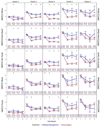Cluster analysis and prediction of treatment outcomes for chronic rhinosinusitis
- PMID: 26806047
- PMCID: PMC4826845
- DOI: 10.1016/j.jaci.2015.11.019
Cluster analysis and prediction of treatment outcomes for chronic rhinosinusitis
Erratum in
-
Correction.J Allergy Clin Immunol. 2016 Nov;138(5):1499. doi: 10.1016/j.jaci.2016.09.005. J Allergy Clin Immunol. 2016. PMID: 27817801 No abstract available.
Abstract
Background: Current clinical classifications of chronic rhinosinusitis (CRS) have weak prognostic utility regarding treatment outcomes. Simplified discriminant analysis based on unsupervised clustering has identified novel phenotypic subgroups of CRS, but prognostic utility is unknown.
Objective: We sought to determine whether discriminant analysis allows prognostication in patients choosing surgery versus continued medical management.
Methods: A multi-institutional prospective study of patients with CRS in whom initial medical therapy failed who then self-selected continued medical management or surgical treatment was used to separate patients into 5 clusters based on a previously described discriminant analysis using total Sino-Nasal Outcome Test-22 (SNOT-22) score, age, and missed productivity. Patients completed the SNOT-22 at baseline and for 18 months of follow-up. Baseline demographic and objective measures included olfactory testing, computed tomography, and endoscopy scoring. SNOT-22 outcomes for surgical versus continued medical treatment were compared across clusters.
Results: Data were available on 690 patients. Baseline differences in demographics, comorbidities, objective disease measures, and patient-reported outcomes were similar to previous clustering reports. Three of 5 clusters identified by means of discriminant analysis had improved SNOT-22 outcomes with surgical intervention when compared with continued medical management (surgery was a mean of 21.2 points better across these 3 clusters at 6 months, P < .05). These differences were sustained at 18 months of follow-up. Two of 5 clusters had similar outcomes when comparing surgery with continued medical management.
Conclusion: A simplified discriminant analysis based on 3 common clinical variables is able to cluster patients and provide prognostic information regarding surgical treatment versus continued medical management in patients with CRS.
Trial registration: ClinicalTrials.gov NCT00799097 NCT01332136.
Keywords: Chronic rhinosinusitis; cluster; outcomes; prediction; quality of life; sinusitis; treatment.
Copyright © 2015 American Academy of Allergy, Asthma & Immunology. Published by Elsevier Inc. All rights reserved.
Conflict of interest statement
Figures




References
-
- Smith TL, Kern RC, Palmer JN, Schlosser RJ, Chandra RK, Chiu AG, et al. Medical therapy vs surgery for chronic rhinosinusitis: a prospective, multi-institutional study. International forum of allergy & rhinology. 2011;1(4):235–241. Epub 2012/01/31. doi: 10.1002/alr.20063. PubMed PMID: 22287426. - PubMed
-
- Smith TL, Kern R, Palmer JN, Schlosser R, Chandra RK, Chiu AG, et al. Medical therapy vs surgery for chronic rhinosinusitis: a prospective, multi-institutional study with 1-year follow-up. International forum of allergy & rhinology. 2013;3(1):4–9. Epub 2012/06/28. doi: 10.1002/alr.21065. PubMed PMID: 22736422. - PubMed
-
- Smith KA, Smith TL, Mace JC, Rudmik L. Endoscopic sinus surgery compared to continued medical therapy for patients with refractory chronic rhinosinusitis. International forum of allergy & rhinology. 2014;4(10):823–827. Epub 2014/09/13. doi: 10.1002/alr.21366. PubMed PMID: 25213088; PubMed Central PMCID: PMC4182136. - PMC - PubMed
-
- Fokkens WJ, Lund VJ, Mullol J, Bachert C, Alobid I, Baroody F, et al. European Position Paper on Rhinosinusitis and Nasal Polyps 2012. Rhinology Supplement. 2012;(23):3. p preceding table of contents, 1–298. Epub 2012/07/07. PubMed PMID: 22764607. - PubMed
-
- Soler ZM, Hyer JM, Ramakrishnan V, Smith TL, Mace J, Rudmik L, et al. Identification of chronic rhinosinusitis phenotypes using cluster analysis. International forum of allergy & rhinology. 2015;5(5):399–407. Epub 2015/02/20. doi: 10.1002/alr.21496. PubMed PMID: 25694390; PubMed Central PMCID: PMC4428937. - PMC - PubMed
Publication types
MeSH terms
Substances
Associated data
Grants and funding
LinkOut - more resources
Full Text Sources
Other Literature Sources
Medical

